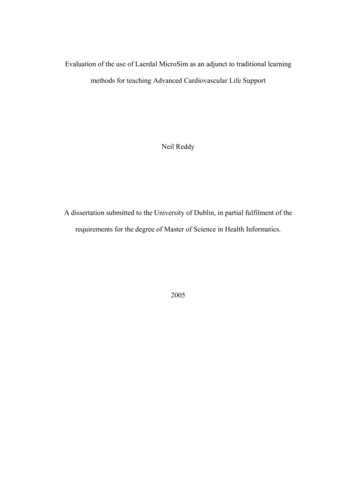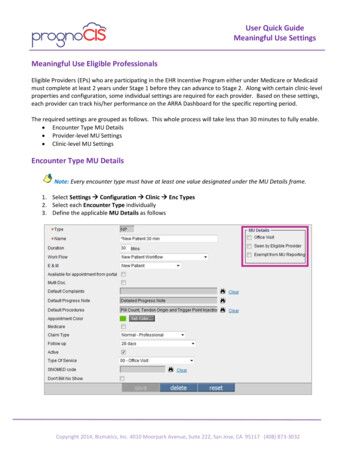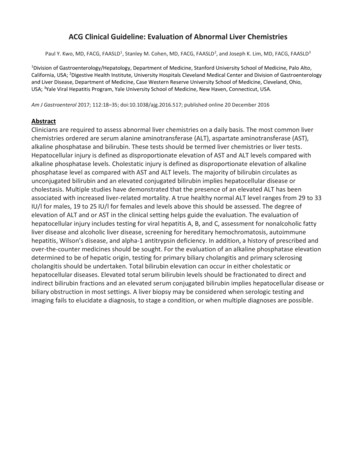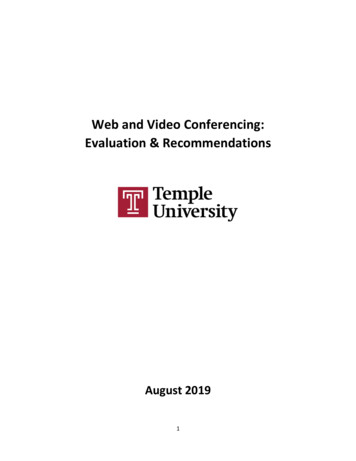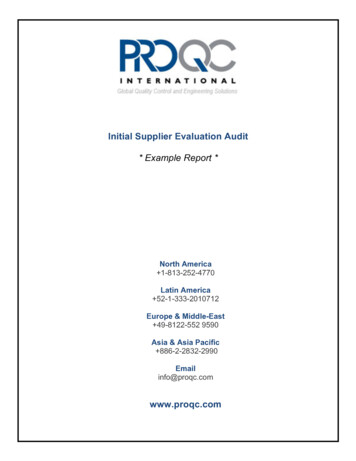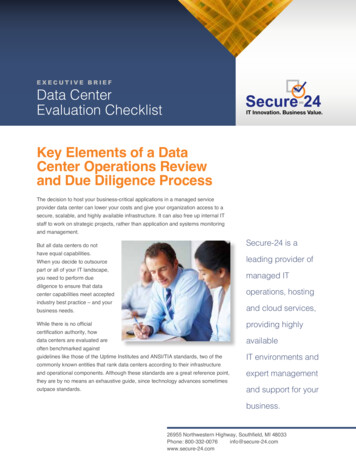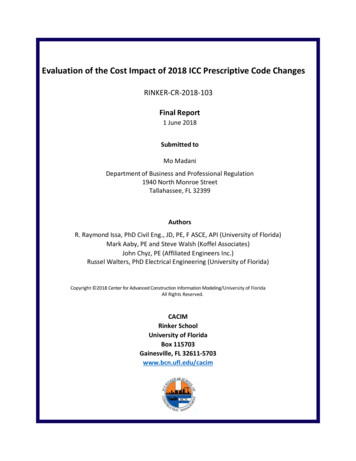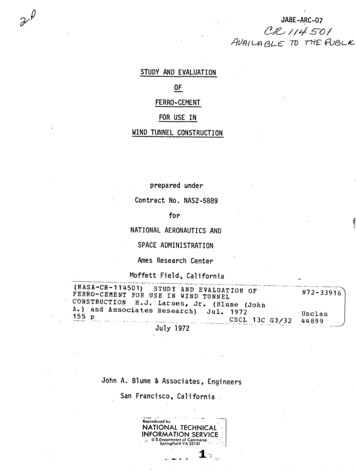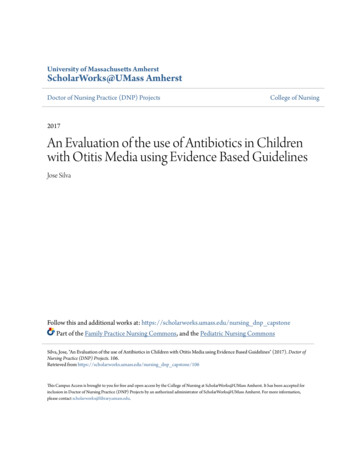
Transcription
University of Massachusetts AmherstScholarWorks@UMass AmherstDoctor of Nursing Practice (DNP) ProjectsCollege of Nursing2017An Evaluation of the use of Antibiotics in Childrenwith Otitis Media using Evidence Based GuidelinesJose SilvaFollow this and additional works at: https://scholarworks.umass.edu/nursing dnp capstonePart of the Family Practice Nursing Commons, and the Pediatric Nursing CommonsSilva, Jose, "An Evaluation of the use of Antibiotics in Children with Otitis Media using Evidence Based Guidelines" (2017). Doctor ofNursing Practice (DNP) Projects. 106.Retrieved from https://scholarworks.umass.edu/nursing dnp capstone/106This Campus Access is brought to you for free and open access by the College of Nursing at ScholarWorks@UMass Amherst. It has been accepted forinclusion in Doctor of Nursing Practice (DNP) Projects by an authorized administrator of ScholarWorks@UMass Amherst. For more information,please contact scholarworks@library.umass.edu.
Running head: OTITIS MEDIA IN CHILDREN PREVENTING OVERUSE OF ANTIBOTICS1An Evaluation of the use of Antibiotics in Children with Otitis Media using Evidence BasedGuidelinesJose SilvaUniversity of Massachussetts AmherstCollege of NursingCapstone Chair:Pamela Aselton, PhD, MPH, FNP-BCCapstone Committee Member:Elizabeth Hennenman, PhD, CCNS, RNCapstone Mentor:Patricia Sweder, DNP, FNP-BCDate of Submission:May 2, 2017
OTITIS MEDIA IN CHILDREN PREVENTING OVERUSE OF ANTIBIOTICS 2Table of ContentsAbstract .5Introduction and Background .6Problem Statement .7Review of the Literature .8Synthesis .11Theoretical Framework .13Project Design and Methods .14Settings and Resources .14Description of the group, population or community .15Organizational analysis of project site .15Facilitators and barriers.16A. Goals, Objectives and Outcomes .16B. Implementation Plan .17C. Ethics . .19Result .20Discussion .24
OTITIS MEDIA IN CHILDREN PREVENTING OVERUSE OF ANTIBIOTICS 3Nursing Implications .25Limitations.26Conclusion .26References .29Appendices .36Appendix A .36Appendix B . .38Appendix C .39Appendix D .40Appendix E .41Appendix F .42Appendix G .43Appendix H .44Appendix I .45Appendix J .46Appendix K .47Appendix L .48
OTITIS MEDIA IN CHILDREN PREVENTING OVERUSE OF ANTIBIOTICS 4Appendix M .49Appendix N .50Appendix O .51Appendix P .52Appendix Q .53Appendix R .54Appendix S .56Appendix T .57Appendix V .58
OTITIS MEDIA IN CHILDREN PREVENTING OVERUSE OF ANTIBIOTICS 5AbstractBackground: Otitis media is a common medical condition that practitioners need to accuratelydiagnose and treat using evidence based guidelines to avoid overprescribing antibiotics. The aimof this project was to gain understanding of practitioners’ knowledge of the evidence basedguidelines for the treatment of otitis media and survey them with regards to their experienceabout adherence to best practice guidelines for the treatment of otitis media and indications forantibiotic use.Methods: Excerpts from published guidelines and decision making on treating otitis media wereprovided by email to a group of Nurse Practitioners (NPs) practicing in clinic settings in theNortheast. This information was accompanied by an online survey regarding NPs knowledge andcomfort with the interpretations of AAP/AAFP guidelines and identify their antibiotic use practices for Acute Otitis Media (AOM).Result: The majority (97%) of the NPs surveyed believed that antibiotics were being overprescribed for AOM. While most (86%) stated they adhered to current AAP/AAFP guidelines forthe diagnosis and treatment of AOM including first line antibiotic choice, 17% admitted to notfeeling comfortable delaying the start of antibiotics in early cases as recommended.Conclusions: Nurse Practitioners rely on scientific literature and evidence based guideline forpractice to make informed decisions regarding antibiotic use for AOM, however they are reluctant to delay antibiotics for AOM in children due to parental pressure. Most felt comfortablediagnosing AOM, however not all felt the highest level of comfort with the otoscope and tympanometry.Keywords: otitis media, overuse antibiotic, otitis children
OTITIS MEDIA IN CHILDREN PREVENTING OVERUSE OF ANTIBIOTICS 6Introduction and BackgroundOtitis media is common in pediatric patients. According to Casey, 2015 Otitis media(OM) with effusion is the most common cause of hearing loss in children, leading to problemsincluding a delay in speech and language development. In the United States in 2008 approximately eight million children were diagnosed with otitis media (Nash, 2013). Seventy-five percent of children experience at least one episode of otitis media by the time they turn three yearsof age. It is estimated that almost half of these children will have more than three OM infectionsduring their first three years of life (Monasta, Ronfani, Marchetti, Montico, Brumatti, Bavcar, &Tamburlini, 2012).The American Academy of Pediatrics (2013) defines acute otitis media (AOM) as the quickonset of signs and symptoms of middle ear inflammation and defined by the presence of fluid inthe middle ear accompanied by signs or symptoms of acute illness. According to Richardson,2013, AOM can be further classified as: 1) uncomplicated - without the presence of otorrhea; 2)severe - which requires the presence of moderate to severe otalgia or a fever of at least 39 degrees Celsius; 3) non-severe- characterized by mild otalgia and a temperature below 39 degreesCelsius; or 4) recurrent, requiring at least three documented and distinct AOM episodes in thelast six months or four or more episodes in the last twelve months and one or more episode in thelast six months. Otitis media with effusion is defined as OM that includes ear discharge. Thedisease peaks in the first three years of life and is less common in the school-aged child, adolescents, and adults (Edwards, 2013).
OTITIS MEDIA IN CHILDREN PREVENTING OVERUSE OF ANTIBIOTICS 7Diagnosis of AOM can be challenging, as AOM can present with a wide range of symptoms as the condition progresses (AAP, 2013), and other diagnoses present with similar symptoms (Nash, 2013). The treatment of AOM can have a wide range of complications that wouldmandate the choice of antibiotics while minimizing patient’s complications. Some complicationsmay prevent the patient complaint with prescribe medication (El-Shabrawi, Tolba, & El-Adly,2016). Some short-term complications include: mastoiditis, labrynthitis, facial nerve paralysis,petrositis, hearing loss, subperiosteal abscess. Long-term complications include: speech and language delay, tympanic membrane perforation, cholesteatoma, tympanic membrane retractionpockets, hearing loss, chronic otorrhea, cognitive impairment.Modifiable risk factors such as introducing infants into large day care groups increasethe incidence of respiratory infections and otitis media. At least one episode of respiratory tractinfections a month occurs during the first year of life, and otitis media is marked by about onethird to one half of the respiratory tract infections (Tapainen, Paarlane, Arkkola, Renko, Pokka,Kaijalainen, & Uhari, 2014) and a lack of knowledge of how otitis media may interact withother, chronic conditions.Problem StatementAccording to the Centers for Disease Control and Prevention, 2015 Otitis media has ahigh prevalence, with well over 20 million episodes of acute otitis media alone occurring in theUnited States every year. The annual costs of office visits, antibiotics, and surgeries related toOM have been estimated to be approximately 4 billion in the United States (Underwood & Bakaletz, 2011). The high prevalence and treatment costs of otitis media with antibiotics; increasedrates of hearing loss and long term complications of late speech and language development; and
OTITIS MEDIA IN CHILDREN PREVENTING OVERUSE OF ANTIBIOTICS 8the challenges of inappropriate antibiotic use to treat otitis media are important challenges. Oneof the main risk with over prescribing antibiotics is that increases the chances of developing resistance. It is important to intervene now to prevent the risk of antibiotics not been able to treatotitis media. Antibiotics should only be prescribed when necessary and after an assessment of thepatient’s condition.Review of the LiteratureA search of the EBSCO database was conducted using the keywords 'otitis media' AND'guidelines' AND 'adherence' OR 'attitudes'. Inclusion criteria for articles consisted of publication in the last ten years regarding the adherence of clinicians to best practice guidelines for thediagnosis or treatment of otitis media in children. Studies were excluded if the study populationor methods of the study could not be clearly identified.The variability in how and why antibiotics are prescribed for OM has been well researched, and the fact that overuse in the pediatric population is more likely than for adults (ElShabrawi, Tolba, & El-Adly, 2016). Furthermore, the most important contributing factor for resistance to antibiotics is overuse. Prescribing antibiotics for too long or too short a time period,and when not necessary may destroy the normal intestinal flora allowing opportunistic pathogensthat are resistant to survive and take over (Dooling, Shapiro, Van Beneden, Hersh, & Hicks,2014).Younger patients seem to be at added risk for overprescribing of antibiotics and should bethe focus of proper assessment appropriate treatment with antibiotics (Roditi, Liu, Bellmunt,Rosenfeld, & Shin, 2016). One of the most important treatment issues with otitis media is theamount and selection of antibiotics prescribed to treat children. There is also the problem thattwo small a small number of new antibiotics are being developed to treat bacterial infections.
OTITIS MEDIA IN CHILDREN PREVENTING OVERUSE OF ANTIBIOTICS 9In one comprehensive study, McGrath, Becker-Dreps, Pate, and Brookhart (2013) examined trends in antibiotic dispensing patterns to treat AOM, as well as trends in antibiotic failure.Researchers found that prescribers prescribed antibiotic when there was no need to treat with antibotics. Using the MarketScan Commercial Claims and Encounters database, the authors examined over 4 million cases of children between three months and twelve years of age diagnosedwith AOM between January, 2000 and December, 2011. The authors found a great deal of fluctuation in the proportion of patients being prescribed antibiotics: 66% in 2005, 51.9% in 2007,and 57.6% in 2011, for instance. Prescription of amoxicillin, recommended by AAP/AAFPguidelines, also fluctuated over the 12 years, for example between 57% and 53% in 2005-2008.Antibiotic treatment failure was approximately 10%, with slight decreases over time. The researchers also note a surprisingly high rate of antibiotic prescription (42.2%) for children diagnosed with OME, despite treatment guidelines recommending watchful waiting over use of antibiotics. These fluctuations in overall antibiotics prescription (amoxicillin in particular) suggestsome lack of consistency in practitioners following published guidelines for treating otitis mediain children, as well as a lack of adherence to guideline recommendations regarding antibioticprescription following OME diagnosis.Other researchers have examined factors that can influence antibiotic prescription/selection. For instance, Fleming-Dutra, Shapiro, Hicks, Gerber, and Hersh (2014), attempted to determine whether race is associated with differences in OM diagnosis and antibiotic prescribing inthe United States. They used the National Ambulatory Medical Care Survey and National Hospital Ambulatory Medical Care Survey to examine 4,178 OM visits between 2008 and 2010 forpatients under 14 years of age. The researchers found that the rate of OM diagnosis was 30%lower in black children than non-black children, despite a lack of differences in OM prevalence
OTITIS MEDIA IN CHILDREN PREVENTING OVERUSE OF ANTIBIOTICS 10between black and non-black children. In cases in which antibiotics were prescribed, black children were also found to be less likely to be prescribed broad-spectrum antibiotics (42%) thannon-black children (52%). While it is not clear whether the disparity indicates undertreatment ofOM in black children or overtreatment in non-black children, the literature on antibiotics prescribing again includes inconsistency that is difficult to rationalize.Questions raised in the literature include the efficacy of amoxicillin/clavulanaic and cefdinir as treatment for OM among children. Casey, Block, Hedrick, Almudevar, and Pichichero(2012) conducted a prospective, randomized, investigator-blind trial to compare the clinical efficacy of 10 days of amoxicillin/clavulanaic acid high dose therapy with five days of cefdinir therapy for treating AOM at recommended doses. Three hundred and thirty children between sixand 24 months of age who had been diagnosed with AOM were included in the study. Ten daysof amoxicillin/clavulanic acid high dose therapy were found to result in a significantly highercure rate (86.5%) than 5 days of cefdinir therapy (71%), confirming that amoxicillin/clavulanaicshould be a preferred first option over cefdinir for treating AOM in children.Often patients ask and expect antibiotics, and although perceived patient expectations areimportant, the provider is responsible and it is expected to educate patients in the appropriate useof antibiotics. Providers are likely to prescribe antibiotics if they believe patients expect them.Cases of bacterial infections are the easiest infections for patients able to diagnose accurately. Patients sometimes do not realize that differentia between bacterial and viral infections isimportant, and most do not realize that antibiotics do not work against viral infection. (Ikram,Ahmed, Siddiqui, Maqbool, Mushtaq, & Sohail, 2015).The overuse of antibiotic use can lead to antibiotic resistance. Resistance to antibioticshas forced us to relook at how we view diseases and the way patients are treated (Teillant,
OTITIS MEDIA IN CHILDREN PREVENTING OVERUSE OF ANTIBIOTICS 11Gandra, Barter, Morgan, & Laxminarayan, 2015). The more an antibiotic is used, the morequickly resistance occurs by allowing opportunistic pathogens that are resistant to survive andtake hold. Unnecessary prescriptions make infections harder to treat later. Clinicians often overprescribe antibiotics even when they believe that antibiotics are only minimally effective for avariety of reasons including patient’s insistence.The overuse of antibiotics leads to antibiotics being less effective in future treatment. Providersthat adhere to guidelines of delayed prescribing of antibiotics and only giving antibiotics if theircondition worsens help to combat the overuse of antibiotics. One study found that nurse practitioners prescribe antibiotics at a higher rate than doctors in outpatient settings (Sanchez, Hersh,Shapiro, Cawley, & Hicks, 2016). Nurse practitioners understand that education is an integralpart of patient care and spend time explaining consequences of inappropriate antibiotic use to patients and family (Duffin, & Griffin, 2015). Patient education is an important tool in promotingthe proper use of antibiotics. Proper use of antibiotics on only bacterial infections can reduce thewidespread and inappropriate use that results in increase in antibiotic-resistant bacteria. Antibiotics are to be used against bacterial infections and not viral infections (Klompas & Rhee, 2016).SynthesisA number of evidenced-based practice guideline demonstrate that patients and familiespersuade or place pressure on providers to prescrib
This Campus Access is brought to you for free and open access by the College of Nursing at ScholarWorks@UMass Amherst. It has been accepted for inclusion in Doctor of Nursing Practice (DNP) Projects by an authorized administrator of ScholarWorks@UMass Amherst. For more information, pleas


